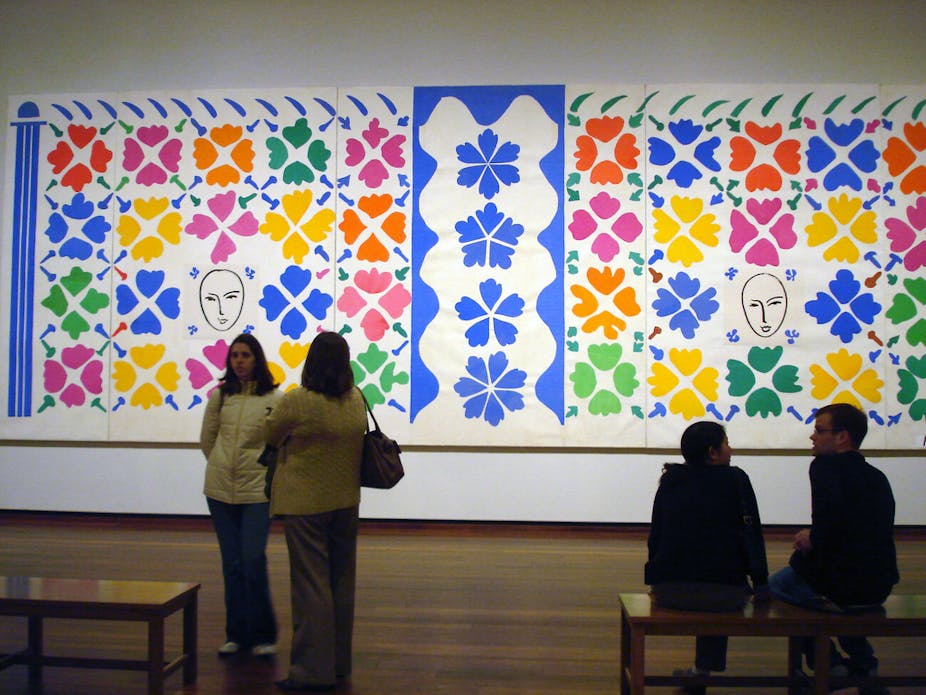It’s billed as a five-star, must-see, once-in-a-lifetime experience. And tickets for the exhibition of Henri Matisse: The Cut-Outs at Tate Modern are already selling fast. Advance booking is recommended, and the Tate website warns anyone rash enough to turn up without a ticket that they can expect a lengthy queue for entry. For those who can’t make the journey to London, there is the compensation of the film of the exhibition “coming to a cinema near you” on 3 June, now part of the standard marketing of a blockbuster exhibition.
Critics’ response to the exhibition has been almost unanimously positive. The display been described as sensitive and serious: no small achievement in curating art that is superficially so decorative and apparently so familiar.
However well we thought we knew Matisse’s joyous graphic images from reproductions in print and online, it turns out there is no substitute for seeing the delicate layers and precise colours of the gouaches découpés. That is, if you don’t mind edging your way in front of each artwork and then craning your neck to see from behind the row of heads that inevitably form a barrier between you and the object of the exhibition.
Matisse’s wonderful cut-outs are the latest manifestation of the contemporary exhibition truism: the higher the cost of admission, the poorer the quality of the viewing experience. The top-price tickets for Matisse are £18 for full-price adult admission, including a gift aid donation to Tate, which is the same as the current crowd-puller at the British Museum, Vikings: Life and Legend. There is no shortage of visitors for either show, but are they worth it?
Even when admission numbers to an exhibition are deliberately restricted (as in the 2012 Leonardo exhibition at the National Gallery), visitors are obliged to shuffle between artworks and wait their turn before getting close to any of the pieces. Tate Modern is notorious for not limiting numbers to its big shows: the term “gallery rage” first gained currency during its unbearably busy Gauguin exhibition in 2010.
One blogger has already commented that, unless you are on the guest list for one of the growing number of exhibition previews, the Matisse show has, in effect, already ended, because seeing the works will be practically impossible during “ordinary” opening hours.
So, what exactly are we paying £18 for? The (remote) possibility of seeing the artworks up close and personal is only part of the picture, of course. For the past 200 years, exhibition visiting has been as much a social as a cultural experience: spectatorship is about seeing, but also about being seen and being able to talk about it afterwards. Museums like Tate understand this well. Exhibitions turn art into an event.
These are not only opportunities for art historical research, comparison and interpretation, they are media-primed, commercial productions. This is crucial to boosting visitor figures and maintaining the museum’s brand profile. The economics are complex: exhibitions are costly (transport, insurance, design, promotion etc.), but they can also be lucrative (sponsorship, admissions, merchandise). The ticket price is as much a cipher of the marketability and prestige of an exhibition as it is a calculation of box office income needed to defray the costs of production.
Would an £18 exhibition ticket seem as pricey in, say, New York, where adult admission to the Museum of Modern Art and the “recommended” admission for the Metropolitan Museum of Art is already $25? Perhaps not, and there’s the rub for national museums in the UK.
The introduction of free admission to national museums in 2001 reinforced the principle that these great public collections somehow belong to each of us, morally if not legally. Both the public funding and the authority of an institution such as Tate are predicated on this idea. And if we believe in free access to art, we may well baulk at forking out £18 for an exhibition, despite knowing very well that this is cheap compared with the cost of a theatre or sports ticket, or even a round of drinks. Not to mention the fact that, when we are on holiday, we are willing to stump up the entry charges to local museums.
And there is that little matter of the “gift aid donation” included in the £18 ticket. The full-price adult ticket is really £16.30, and there is the opportunity to pay this, but it is well down the list of prices. The additional £1.70 is pitched as a charitable donation which, under UK gift aid legislation, enables the Tate to reclaim the tax already paid on the value of the £18 ticket.
It’s a neat fundraising idea, but it may be a surprise to learn that Tate can benefit from the top-up on your exhibition ticket because it is a charity, as well as a state-sponsored, non-departmental public body. It may be less surprising to discover that visiting the Henri Matisse: The Cut-Outs feels like shopping on the first day of the January sales. Paying £18 to contemplate Matisse’s cut-outs without the crowds would be the bargain of the year, but that isn’t what’s on offer this spring at Tate Modern.

